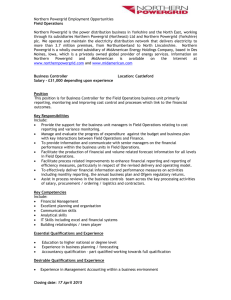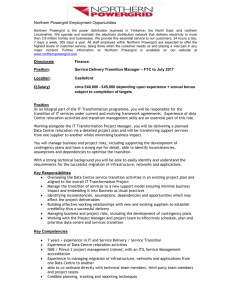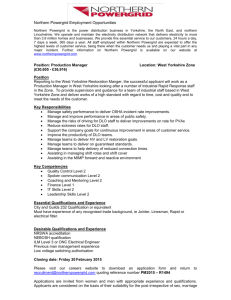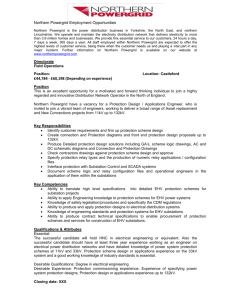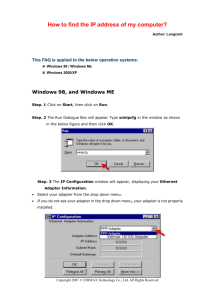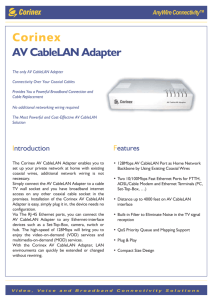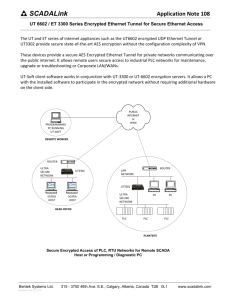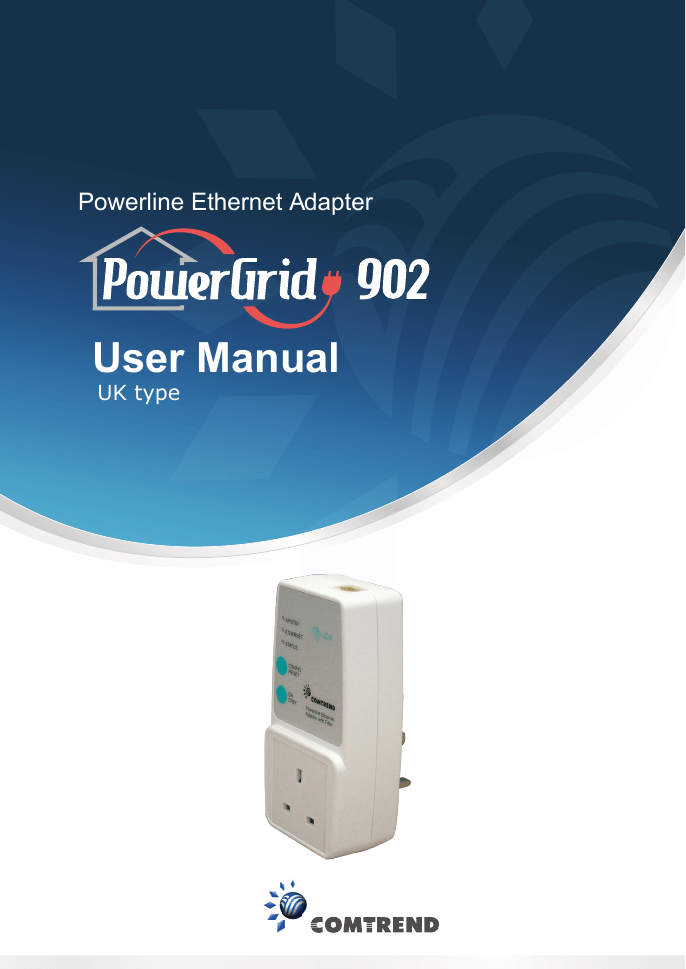
PowerlineEthernetAdapter
User Manual
UK type
Introduction
This user manual provides practical information for the
installation, operation and application of the device. It is
suitable for those with little or no networking experience,
although some advanced topics are also covered.
A glossary of acronyms is included in Appendix A for
reference.
Save Our Environment
This symbol means that when the equipment has
reached the end of its useful life, it must be taken
to a recycling centre and processed separate from
domestic waste.
The cardboard box, the plastic contained in the packaging,
and the parts that make up this device can be recycled in
accordance with regionally established regulations.
Never throw this electronic equipment out along with
your household waste. You may be subject to penalties or
sanctions under the law. Instead, ask for instructions from
your municipal government on how to correctly dispose of it.
Please be responsible and protect our environment.
Copyright
Copyright© 2008 Comtrend Corporation. All rights reserved.
The information contained herein is proprietary to Comtrend
Corporation. No part of this document may be translated,
transcribed, or reproduced in any form or by any means
without prior written permission of Comtrend Corporation.
NOTE: This document is subject to change without notice.
Table of Contents
Chapter 1 - Introduction Chapter 2 - Basics
2.1 Device Layout
2.2 Front Panel
2.3 Default Settings Chapter 3 - Quick Setup 3.1 Internet Connection
3.2 Computer Connection
Chapter 4 - Network Performance
4.1 Point-to-Point Network 4.2 Point to Multipoint Network
4.3 Neighboring Networks Chapter 5 - Web User Interface
5.1 IP Configuration
5.1.1 Fixed IP
5.1.2 DHCP Server
5.2
5.3
5.4
5.5
18
22
Login Screen
WUI homepage Advanced Information
5.4.1
5.4.2
5.4.3
5.4.4
System Information Screen
Network Screen
MAC Screen
PHY Screen
Change Configuration
5.5.1
5.5.2
5.5.3
5.5.4
5.5.5
5.5.6
3
4
4
5
6
7
7
9
13
14
15
16
18
18
Network Screen
MAC Screen
PHY Screen
Security Screen
Hardware Reset
Upgrade
Chapter 6 - HELP 6.1 Troubleshooting
6.2 FAQ
Appendix A - Acronyms 26
27
28
29
29
30
31
32
32
33
34
35
36
36
38
38
41
44
Chapter 1 - Introduction
This user guide provides details concerning the installation,
configuration and application of COMTREND Corporation’s
PowerGrid 902 Powerline adapter.
The PowerGrid 902 is the first of its kind to incorporate an
AC filter with rear socket. It allows for the connection of the
adapter to the electrical grid of a home without depriving
the user of a single power outlet.
The PowerGrid 902 is the physical link between Powerline
and Ethernet (10/100M) networks. The design is such
that, on the one hand, it avoids limiting a power socket
to just PLC purposes, and on the other hand, provides a
filtered power socket to avoid interference from appliances
connected to it.
The front panel of the PowerGrid 902 has two buttons
and three LEDs that allow the user to configure a secure
PLC network without the use of a computer. The Status
LED shows the available level of data throughput in the
application layer.
SPECIAL FEATURES
One Button Security Setup - Automatic generation of
an Encryption Key and Network Identifier by pressing a
single button!
Throughput Indicator - A tri-color Status LED that
shows estimated data throughput in the application
layer
Rear Socket with AC Filter - Plug the PowerGrid 902
into a power outlet without losing use of the outlet for
other applications.
Chapter 2 - Basics
2.1 Device Layout
The following figure shows the physical layout of the
PowerGrid 902 adapter.
LAN the yellow port
located on top
AP/STBY
ETHERNET
STATUS
FRONT PANEL
CONFIG
RESET
ON
STBY
Powerline Ethernet
Adapter with Filte r
POWER OULET
– AC Filtered
Outlet located in
front
POWER PLUG
– located in
back
2.2 Front Panel
This table provides descriptions of the front panel
buttons and LEDs.
Button
Function
CONFIG/RESET
(Security Setup /
Factory Reset)
Press for “One Button Security Setup”. Holding down the button for a long period
will result in a “Factory Reset”.
ON/SBY
(Power ON /
Standby button)
Used to switch the adapter between ON and
STANDBY (Power Saving) modes. Turning
off the adapter will also set the “Status” &
“Ethernet” LEDs to “off”
LED
Function
•Red: Adapter is ON. If PLC link, Estimated
Application Throughput < Threshold 1
(6Mbps).
STATUS*
•Orange: if PLC link, Threshold 1 (6Mbps)
< Estimated Application Throughput <
Threshold 2 (12Mbps).
•Green: if PLC link, Estimated Application
Throughput > Threshold 2 (12Mbps)
•BLINKING (in RED, ORANGE or GREEN):
Traffic in the Ethernet port.
• Green On: LAN connection established.
ETHERNET
• Off: LAN connection is not established.
• Blinking: Data transmitting/receiving
•Red: Adapter in Standby mode.
•Green (steady): Fixed AP (access point).
AP/STBY
•Green (blinking): Fixed AP is searching.
•Off: Adapter in EP (End Point) mode.
•3 Flashes: EP has exchanged keys with
AP
* see
Chapter 4 – Network Performance for more details.
2.3 Default Settings
The factory default settings are presented below.
•Network Mode is AP (Public)
•IP Configuration is DHCP
•MAC Type is In-Home AV
•Node type is End Point
•Configuration password = admin
•Factory Reset password = admin
•Fixed IP address = 10.10.1.69
•Fixed IP subnet mask = 255.255.0.0
•Default Gateway IP address = 192.168.1.105
NOTE: These configuration settings can be customized using
a web browser. For further instructions, see Chapter 5
- Web User Interface. To return the adapter to factory
default settings, follow the FACTORY RESET procedure in
the Troubleshooting section of this manual.
Chapter 3 - Quick Setup
PowerGrid 902 units are configured by default with flexible
network settings.
As a result, when they are plugged into the power mains of
a home they will connect to an already existing PowerGrid
network. If there is no existing network they will create a
new network that will operate smoothly but without enhanced
security features.
This is why it is recommended to reconfigure your PowerGrid
902 units to form a secure network (with a unique network
identifier and encryption key). This can be accomplished
using just the front panel buttons on the PowerGrid units. The
following sections describe how to setup a secure network in
this way.
NOTE: You will need a single PowerGrid 902 unit and Ethernet
cable for each computer, or other device, that you wish to
connect to the Internet.
3.1 Internet Connection
The steps below show how to connect a PowerGrid 902
unit to your modem.
1.Turn on your modem and wait for
the Internet connection to become
active.
2.Plug a PowerGrid 902 unit into the
power socket closest to the modem as
in figure 1 (at right). The Status LED
on the front panel of the unit should
light up RED.
3. As in figure 2, connect the PowerGrid
902 unit to the LAN port of the modem
with an Ethernet cable. The ETHERNET LED on the
unit should light up GREEN.
AP UNIT CONFIGURATION
A PowerGrid network consists of one AP (Access Point)
unit connected to multiple EP (End Point) units. The
AP unit controls access to the Internet and connects
the EP units to the network. Follow step 4 (below) to
configure the AP unit.
4.As shown in figure 3, press the CONFIG/RESET button
on the PowerGrid 902 unit. Wait for the AP/STBY LED
to start blinking and then release it. Wait another
thirty (30) seconds until it stops blinking and check
the AP/STBY LED. If the AP/STBY LED is now ON, then setup was
successful and you can now proceed to section 3.2,
where you will configure the EP unit. If AP/STBY LED is now OFF, or just keeps blinking,
you must first press the CONFIG/RESET button for 15
seconds to reset the unit and repeat step 4.
After several attempts, if the AP/STBY LED does not
stay ON, then disconnect the PowerGrid 902 unit from
the modem and the power socket, choose another
unit and repeat the process from step 2.
If all else fails, contact your supplier or service
provider for further assistance.
3.2 Computer Connection
The steps below show how to connect a PowerGrid 902
unit to your computer.
1.Turn on your computer.
2.Plug a PowerGrid 902 unit into
the power socket closest to the
computer. The Status LED should
light up RED, as in figure 1.
3.Connect the PowerGrid 902 to the
computer with an Ethernet cable,
see figure 3. The ETHERNET
LED on the unit should light up
GREEN.
EP UNIT CONFIGURATION
As previously discussed, a PowerGrid network can
have only one AP unit. This unit was configured in
section 3.1. All other units must be set as EP units.
To do so, follow these steps:
4.As shown in figure 5, press the CONFIG/RESET button
on the AP unit until the AP/STBY LED starts blinking
and then release it. You now have thirty (30) seconds
to complete the EP set up.
5.Before the AP unit AP/STBY LED stops blinking, press
the CONFIG/RESET button on the PowerGrid 902
that you wish to configure as an EP unit. Wait for its
AP/STBY LED to start blinking and then release the
button. After a few seconds, the AP/STBY LED should
flash quickly three times and then turn OFF, as shown
in figure 6.
10
If the AP/STBY LED of the EP unit is now OFF, then
proceed to step 6.
If the AP/STBY LED of the EP unit is now ON, or just
keeps blinking, you must press CONFIG/RESET for 15
seconds and then return to step 4.
After several tries, if the AP/STBY LED of the EP unit
does not remain OFF, then disconnect it from its
power socket and from the computer, or other device.
Select another EP unit, if possible, and repeat the
process from step 2.
If all else fails, contact your supplier or service
provider for further assistance.
6.After adding the EP unit to the PowerGrid
network, check that the AP/STBY LED on
the AP unit has stopped blinking and
remains ON, as in figure 7.
If the AP/STBY LED on the AP unit is
now OFF, or just keeps blinking, you
must first reset the unit and then try
again. To reset the unit, press CONFIG/
RESET for 15 seconds. Then return to
step 4 in section 3.1 and repeat section
3.2 for every device you wish to add to
the network.
After several tries, if the AP/STBY LED
11
on the AP unit does not stay ON, then disconnect it
from the modem and its power socket, choose another
unit to be the AP unit and repeat the entire process
starting from section 3.1, step 2.
If all else fails, contact your supplier for further assistance.
7.If the AP/STBY LED on the AP unit is now ON, then
you have completed the setup successfully.
CONGRATULATIONS!
You can now either:
Add another computer to the network by repeating
steps 1-6
OR
Stop here and start enjoying your secure PowerGrid
network!
NOTE: These PowerGrid 902 units keep their network security
settings even after losing power, so that you don’t need to
reset the network, when moving network devices or even
after a power outage!
12
Chapter 4 - Network Performance
The Status LED shows the estimated available level of
throughput in the application layer.
There are three levels of throughput indicated by three
different LED colours. A particular adapter shows, with one
colour, the throughput level with reference to the adapter
sending the most data to it. In the case of a network consisting
of two adapters, they always show the level of throughput
with reference to the other. However, in the case of a network
of three or more adapters, each one internally measures
the amount of bytes received from the other adapters in
the network and only shows the level of throughput with
reference to the one that is sending the most data.
A throughput estimator also keeps track of the number of
neighbouring networks since available bandwidth will be
divided between them when sharing the PLC channel. The
thresholds for these levels of throughput are preconfigured
in the system as shown below.
LED
STATUS
RED
Estimated Throughput < Threshold 1 (6Mbps)
ORANGE
Threshold 1 (6Mbps) < Estimated Throughput <
Threshold 2 (12Mbps)
GREEN
Estimated Throughput > Threshold 2 (12Mbps)
BLINKING
(in any
color)
Traffic in the PLC port
(for each estimated throughput level)
13
4.1 Point-to-Point Network
• CASE 1: Estimated throughput is less than 6 Mbps.
The PLC channel is not able to transmit an SDTV
channel. The STATUS LED will be RED as shown in the
following figure:
SetTopBox
videoserver
dataflow
AP/STBY
AP/STBY
ETHERNET
ETHERNET
E
STATUS
STATUS
S
ST
CONFIG
RESET
ON
STBY
CONFIG
RES ET
ON
STBY
Powerline Ethernet
Adapter with Filt er
PLC
adapter
Powerline Ethernet
Adapter with Filt er
PLC
adapter
StatusindicatorblinkingRED
Estimatedthroughput<Mbps
• CASE 2: Estimated throughput is greater than 6 Mbps
but less than 12 Mbps. The PLC channel is able to
transmit an SDTV channel, but not two SDTV channels
simultaneously or one HDTV channel. The STATUS LED
will be ORANGE as shown in the following figure:
SetTopBox
videoserver
dataflow
AP/STBY
AP/STBY
ETHERNET
E
ETHERNET
STATUS
S
ST
STATUS
CONFIG
RESET
CONFIG
RESET
ON
STBY
PLC
adapter
ON
STBY
Powerline Ethernet
Adapter with Filt er
PLC
adapter
Powerline Ethernet
Adapter with Filt er
StatusindicatorblinkingORANGE
Mbps<Estimatedthroughput<Mbps
• CASE 3: Estimated throughput is greater than 12
Mbps. The PLC channel is able to play at least two
SDTV channels or 1 HDTV. The STATUS LED will be
GREEN as shown here: 14
SetTopBox
videoserver
dataflow
AP/STBY
ETHERNET
AP/STBY
ETHERNET
E
STATUS
S
ST
STATUS
CONFIG
RES ET
CONFIG
RESET
ON
STBY
ON
STBY
Powerline Ethernet
Adapter with Filt er
PLC
adapter
Powerline Ethernet
Adapter with Filt er
PLC
adapter
StatusindicatorblinkingGREEN
Estimatedthroughput<Mbps
4.2 Point to Multipoint Network
In the case where the PLC network is composed of three
or more adapters, similar situations could arise as with
a point-to-point network. These are illustrated in the
following figures:
videoserver
SetTopBox
Estimatedthroughput<Mbps
dataflow
AP/STBY
ETHERNET
STATUS
CONFIG
RESET
ON
STBY
PLC
adapter
AP/STBY
ETHERNET
E
STATUS
S
ST
CONFIG
RESET
ON
STBY
Powerline Ethernet
Adapter with Filt er
Powerline Ethernet
Adapter with Filt er
PLC
adapter
StatusindicatorblinkingGREEN
Mbps<Estimatedthroughput<Mbps
SetTopBox
dataflow
AP/STBY
ETHERNET
E
STATUS
S
ST
CONFIG
RESET
ON
STBY
PLC
adapter
Powerline Ethernet
Adapter with Filt er
StatusindicatorblinkingORANGE
The STATUS LED in each adapter will show the estimated
level of the PLC link from which it is receiving the most
amount of traffic at any given time. The status LED in
PLC adapter 3, for example, could be showing a level of
throughput available from PLC adapter 2 for a period of
time as illustrated in the figure above. However, traffic
flow could change through user intervention and then
15
the status LED in PLC adapter 3 could show the level
with reference to the PLC adapter 1 link, as shown in
the following figure.
videoserver
SetTopBox
Estimatedthroughput>Mbps
AP/STBY
STATUS
S
ST
CONFIG
RESET
ON
STBY
AP/STBY
dataflow
ETHERNET
E
Powerline Ethernet
Adapter with Filt er
ETHERNET
E
STATUS
S
ST
CONFIG
RES ET
ON
STBY
Powerline Ethernet
Adapter with Filt er
StatusindicatorblinkingGREEN
PLC StatusindicatorblinkingGREEN PLC
adapter
adapter
Estimatedthroughput>Mbps
dataflow
SetTopBox
dataflow
Estimatedthroughput<Mbps
AP/STBY
ETHERNET
E
STATUS
S
ST
CONFIG
RESET
ON
STBY
Powerline Ethernet
Adapter with Filt er
PLC
adapter
StatusindicatorblinkingRED
4.3 Neighboring Networks
The Status LED also takes into account the possibility
of having neighbouring networks. In such a case, the
throughput evaluator will divide the available bandwidth
in two when there is visibility between any two networks
since the PLC channel must be shared on a time basis. In
the following figure, an example of an isolated network
is first shown.
ISOLATEDNETWORK
SetTopBox
videoserver
dataflow
AP/STBY
ETHERNET
STATUS
AP/STBY
ETHERNET
E
STATUS
S
ST
CONFIG
RESET
CONFIG
RESET
ON
STBY
PLC
adapter
ON
STBY
Powerline Ethernet
Adapter with Filt er
Powerline Ethernet
Adapter with Filt er
PLC
adapter
StatusindicatorblinkingGREEN
Estimatedthroughput=0Mbps
In the next figure, the previous network (network 1)
16
sees a new neighbouring network (network 2), and a
new evaluation of throughput is made to show the user
that channel conditions have changed and available
bandwidth has decreased:
PLCNETWORK
SetTopBox
videoserver
dataflow
AP/STBY
ETHERNET
AP/STBY
ETHERNET
E
STATUS
S
ST
STATUS
CONFIG
RESET
CONFIG
RESET
ON
STBY
ON
STBY
Powerline Ethernet
Adapter with Filter
PLC
adapter
Powerline Ethernet
Adapter with Filter
PLC
adapter
StatusindicatorblinkingORANGE
Estimatedthroughput=0Mbps/=0Mbps
PLCNETWORK
SetTopBox
videoserver
dataflow
AP/STBY
AP/STBY
ETHERNET
E
ETHERNET
STATUS
S
ST
STATUS
CONFIG
RESET
CONFIG
RESET
ON
STBY
PLC
adapter
ON
STBY
Powerline Ethernet
Adapter with Filter
PLC
adapter
Powerline Ethernet
Adapter with Filter
StatusindicatorblinkingGREEN
Estimatedthroughput=0Mbps/=Mbps
17
Chapter 5 - Web User Interface
The web-based user interface (WUI) provides information
about your PowerGrid 902 units and can also be used to
configure or reset their settings. The WUI is accessed using a JavaScript enabled web browser,
such as Microsoft Internet Explorer. The instructions that
follow assume the PowerGrid network has been configured
correctly (i.e. according to the instructions in Chapter 3 or
the QIG) and that the host computer is running Windows XP. NOTE: The process described in the following sections will work
for any operating system (OS), but the specific steps will
need to be adjusted to match your particular computing
environment.
5.1 IP Configuration
Before using the WUI, you first need to adjust the IP
configuration of the host PC. This is a two-step process
addressed in subsections 5.1.1 and 5.1.2.
FYI:
The IP configuration defines the location of your
computer within the network using Internet Protocol
(IP) addressing. Your computer needs an IP address
so it can receive and send information on the network.
In Fixed IP mode you assign this IP address yourself;
while in DHCP mode it is assigned automatically by a
DHCP server.
5.1.1
Fixed IP
The following instructions describe how to change the IP
configuration of your computer to FIXED IP mode, so
that you can access the WUI.
18
STEP 1: Turn on your computer (and login, if necessary).
STEP 2:From the desktop (as shown below), click on the
Start button and select Network Connections.
Next, double-click Local Area Connections to
open its window and then click the Properties
button.
NOTE:You may also access this window by double-clicking
the Local Area Connection icon on your taskbar.
STEP 3:Select Internet Protocol (TCP/IP) and click
the Properties button.�
19
STEP 4:Check the settings in the Internet Protocol
(TCP/IP) Properties dialog box (shown on
the far right in the figure above). Make sure to
record all the settings you see here, as you will
need to reset them later.
STEP 5:If the “Obtain an IP address automatically” radio
button is selected, then your PC is configured
in DHCP mode. In this case you should select
the “Use the following IP address” radio button
instead.
If it is not selected then your PC is already in
FIXED IP mode.
STEP 6:Change the IP address, Subnet Mask and
Default Gateway to match those values shown
in the figure below and click the OK button.
20
Click OK
STEP 7: Close the previous two windows. Since you made
changes, click OK, but not Cancel! You then must
wait for the LAN connection to reset.
After the connection recovers, you should check the
connection status on the support tab of the Local Area
Connection Status dialog box, as shown below.
This shows the IP
address as assigned
in STEP 6.
Look here for a
status report of
the connection.
21
5.1.2
DHCP Server
Now that we have configured the computer IP configuration,
we now need a DHCP server to provide IP addresses to
the PowerGrid units.
We recommend using TFTPd32, which is free software
you can use for this purpose. It is available on the
Internet at http://tftpd32.jounin.net. A screenshot
of the website is shown below with the download link
indicated.
22
Once you have downloaded and installed this software
please proceed with the instructions on the next page:
STEP 1:There should now be a new TFTPd32 program
icon on your desktop or in the All Programs
folder found in the Windows START menu. Open
TFTPd32 by clicking this icon.
STEP 2:Various functions are accessible from tabs in
the Tftpd32 window. The Tftpd32 window shown
below has Tftp Server, Tftp Client, DHCP server,
Syslog server and Log viewer tabs.
Select the DHCP server tab and continue to
STEP 3.
STEP 3:To configure the DHCP server, copy the settings
as shown below. When finished, click the Save
button (outlined in red) and close Tftpd32 with
the small ‘x’ located in the top right corner of
the window.
23
STEP 4:Restart Tftpd32 and return to the DHCP server
tab, as shown. You will now (or very soon) see
several items listed in the box at the bottom.
Look for any devices with a MAC address starting
with “00:1D:20”.
24
In the example above, there are two PowerGrid
units:
MAC address: 00:1D:20:20:0D:15 with an IP of
10.0.0.1
MAC address: 00:1D:20:20:0D:12 with an IP of
10.0.0.3
Every PowerGrid 902 unit
has a small label on the
plug-side of the unit, with
its MAC address listed
under the product bar
code, as shown at right.
Match the MAC address
of the unit you wish to
access with its IP address.
You can use this IP address to access the WUI for that
unit, as described in section 5.2 Login Screen.
NOTE: If you find any PowerGrid 902 units are missing from this
list, they may have previously acquired an IP address from
the DHCP server on your router. In this case, disconnect
25
your router from the network and reset the affected
units (by holding down the CONFIG/ RESET button for
15 seconds. You may also need to close and restart the
Tftpd32 program to make the DHCP server search once
more for the missing units.
5.2 Login Screen
Perform the following steps to login to the WUI:
STEP 1:Start the Internet browser and enter the IP
address as a HTTP link in the URL address field
and press Enter. For the IP address of 10.0.0.1,
you must enter http://10.0.0.1, as shown below.
STEP 2:The login screen should appear, as shown below.
Enter the login password in top section and click
OK to continue. To perform a factory reset on the
device you must enter the factory reset password
in the bottom section and click OK. The WUI
login password and other default settings can be
found in section 2.3 Default Settings.
NOTE: You can change this password in the WUI (see section 5.5.4).
If you enter an incorrect password or wait too long, the
26
following screen will appear. In this case, refresh the browser
window (press F5 key) and try again.
NOTE: You will also return to the screen above if you leave the
WUI unattended for too long after login. In this instance,
you must login again.
5.3 WUI homepage
If login is successful, you will arrive at the WUI homepage.
This screen lists the available PLC connections and
External Interfaces as shown below. It also provides
access to the Advanced Information and Change
Configuration submenus, using the links on the far
left. These submenus are discussed in detail in section
5.4 and section 5.5 of this manual.
27
See the table below for details.
PLC Connections
PLC PORT
MAC Address
Phy Tx/Rx
Throughput
Bridge State
Network Id
The PLC data connection port
This is a code that identifies each
PowerGrid unit. It can be found on
the back label of the unit below the
barcode.
Physical Transmission / Reception
Throughput is a measure of network
bandwidth. Available data transmission
capacity is roughly half this value.
Enabled indicates there is a data
connection.
Disabled indicates no data connection.
The Network ID is used for network
security.
If present, the network is in FIXED AP
mode.
External Interfaces
Interface
Phy Throughput
Bridge State
EXTA = Ethernet
Physical Throughput = Data Transmission
Capacity
Forwarding = Active
5.4 Advanced Information
This submenu provides more detailed information
concerning your PowerGrid unit and is further subdivided
into the following four screens: System, Network, Mac
and Phy. These screens are accessed with links located
at right (outlined in red).
28
5.4.1
System Information Screen
This screen is shown above and details are provided in
the table below.
Uptime
Firmware
Version
5.4.2
This shows the length of time the PowerGrid
unit has been active.
This shows the PowerGrid 902 installed
firmware version.
Network Screen
This screen shows the TCP/IP settings for this PowerGrid
unit.
NOTE: Most of this information can also be found on the Local
Area Connection Status dialog box (see step 4 of
section 4.1).
29
IP Configuration
IP Address /
Subnet Mask
Default Gateway
IP Address
5.4.3
Either DHCP (Automated) or FIXED IP
(Manual).
These values define the location of the
PowerGrid unit on the local area network.
The IP address of the router that forwards
traffic to a destination that is out of reach
of the PowerGrid 902 unit.
MAC Screen
This screen provides information for identification of the
AP unit (MAC Address), in addition to PowerGrid network
encryption details.
MAC Address
This is a code that identifies each
PowerGrid unit. It can be found on the
back label of the unit below the barcode.
MAC Type
The MAC Address shown above is an InHome AV type.
Node Type
Network
Identifier
This will show as Fixed AP, EP or AP.
This field is used in Fixed AP mode to
identify the network.
The Network ID can be up to 20 ASCII
characters long.
30
Encryption Key
Encryption Type
5.4.4
In Fixed AP mode, it shows a key in ASCII
or HEX format. In AP mode it shows as
Disabled.
The possibilities are 3DES or 128/256 bit
AES (Fixed AP) or None (AP mode)
PHY Screen
This screen summarizes the physical parameters of the
PLC network.
Power Control
Notches
Wireless (27Mhz)
keyboard/mouse
notch
Notch
Customization
Start Frequency
(KHz)
This function minimizes the transmission
power of each PowerGrid unit while
maintaining data throughput performance.
It is always Enabled. Enabled (by default) and cannot be
altered.
Disabled (by default). When Enabled, it
prevents wireless keyboard/mouse signal
interference.
If notches have been set they will appear
here.
The notch start frequency.
31
Stop Frequency
(KHz)
The notch stop frequency.
5.5 Change Configuration
This submenu provides network configuration functions
and is further subdivided into the following screens:
Network, Mac, Phy, Security, Hardware Reset and
Upgrade. These are accessed with links located at right
(as outlined in red below).
5.5.1
Network Screen
The screen shown above provides options to configure
the IP configuration of this PowerGrid 902 unit. The IP
Configuration drop-down box has two options: DHCP
and FIXED. In FIXED mode the IP Address, Subnet
Mask and Default Gateway IP Address can be set
manually, while in DHCP mode they are assigned by a
DHCP server (see section 5.1 for more details).
NOTE: Changes do not become effective until after a reboot of
the PLC unit.
32
5.5.2
MAC Screen
This screen provides options to configure the AP unit MAC
characteristics and network encryption mode.
MAC Type
Node Type
Network Identifier
Encryption Key
Encryption Type
AES Key Length
In-Home AV is the only option at this time.
There are only 2 kinds of nodes either
Fixed AP or EP.
This field is used in Fixed AP mode to
identify the network.
The Network ID can be up to 20 ASCII
characters long.
This key, in either ASCII or HEX format,
is used to encrypt the network. It is
disabled in AP mode.
You have the choice of 3DES or AES
encryption.
AES encryption can be set as 128 or
256 bit strength.
33
NOTES:In 3DES mode, the Encryption Key can be up to 24 ASCII
characters or 42 hexadecimal numbers. In AES mode, it can be
up to 8 ASCII characters or 14 hexadecimal numbers (256 bit
mode). Hexadecimal encryption is stronger.
5.5.3
PHY Screen
This screen provides options to configure the physical
parameters of the network.
Notches
Wireless (27Mhz)
keyboard/mouse notch
Power Control
This is set to Enabled by default and
cannot be altered.
Enable this option when using a
wireless keyboard or mouse to
avoid interference. It is disabled by
default.
This is set to Enabled by default
and cannot be altered. It minimizes
the transmission power of each
PowerGrid unit while maintaining
data throughput performance.
34
Notch Customization
Start Frequency (KHz)
Add/Remove notches in this section.
The notch start frequency.
Stop Frequency (KHz)
The notch stop frequency.
5.5.4
Security Screen
This screen allows you to change the configuration
password and perform a factory reset to recover default
settings. To change the configuration password, notice
that you must enter it twice; first in the New password
field and then again in the Confirm new password field. The password can be up to 20 text characters in length.
Click OK to make this change.
To reset the device to factory settings, enter the factory
reset password (see section 2.3 Default Settings) and
click OK. Use this function with caution, since, as noted
onscreen, this will erase the current configuration
settings.
NOTE:To remove the configuration password, just click OK.
35
5.5.5
Hardware Reset
This screen allows for a hardware reset which will reboot
the device but not erase the configuration settings. It
performs the same function as holding down the Config/
Reset button on the front panel of the unit. You must
perform a hardware reset of the device to enable certain
settings, such as the IP mode (DHCP/FIXED).
5.5.6
Upgrade
This screen provides a method to upgrade the flash
memory in the PowerGrid unit from a remote server
using FTP or TFTP protocol. The flash memory is divided
into three sections: the firmware, a boot-loader and
the factory settings. Each of these can be upgraded
separately to provide for maximum flexibility.
36
See the table below for more details.
Status
Flash Section
Upgrade Protocol
Server IP Address
FTP User / Password
Filename
Reports the current status of the flash
upgrade.
Upgrade the firmware, loader or factory
settings.
FTP or TFTP
This will be provided by your service
provider.
Enter the user name and password if
required.
This is the filename of the flash upgrade
on the server. The firmware and loader
will have a .bin extension, while factory
settings are stored as .cfg files.
37
Chapter 6 - HELP
This PowerGrid unit has been designed to be a reliable and
easy-to-use home networking device. However, should you
experience any problems, please refer to the troubleshooting
and FAQ sections below to resolve your issue.
6.1 Troubleshooting
FACTORY RESET
To reset a unit to factory default settings, simply press
the CONFIG/RESET button for 15 seconds. The adapter
will reset its configuration to factory default settings
and auto-reboot. If the reboot is successful, it will be
configured in EP mode. If you reset the AP unit, you
will need to repeat the entire network setup process
described in Chapter 3.NETWORK SETUP
NETWORK SETUP
1.Converting an AP unit into an EP unit:
• Make sure the PowerGrid unit is plugged directly
into the electrical outlet and that it is powered
on.
• Do a factory reset (see the RESET PROCEDURE
above).
2.Converting an EP unit into an AP unit:
• Make sure the PowerGrid unit is plugged directly
into the electrical outlet and that it is powered
on.
• Press CONFIG/RESET button until its AP/STBY
LED starts blinking.
• Wait
until
configuration
38
period
finishes
(30
seconds). At that point the adapter has been
designated as a Fixed AP if its AP/STBY LED is
GREEN.
3.
There MUST only be one Fixed AP in a network.
Verify that this is the case by examining the AP/STBY
LED for all adapters. If there is more than one AP in
the network, it means that the key exchange process
has failed.
• Perform a factory reset on the adapter you do
not wish to be designated as an AP (see step 1
above).
• Repeat the network configuration procedure
again (see Chapter 3).
• If the configuration procedure fails again, it is
possible the adapters are using different forms
of encryption. For example, one might be using
AES and the other 3DES. To eliminate this as a
possibility, perform a factory reset on all adapters
and repeat the configuration process.
• If configuration still fails, connect a PC to each
adapter, and use the WUI tool to ensure that
all PLC devices have the same network ID,
encryption mode and key. If not, try to configure
them in electrical outlets that are nearby to avoid
a communications problem. Once configured,
move the adapters to their final position and test
connectivity again.
• If encryption mode is not the same in the two
adapters, then the EP may not have the ability
to set the AP encryption mode for regulation
issues or because it is from an older generation
when AES was not available. Try to put the AP
in an encryption mode compatible with all PLC
devices, such as 3DES encryption.
39
4.NETWORK PERFORMANCE
If the network is performing slowly or not at all, try
the following:
• Check the ETHERNET LED on every PowerGrid
902 unit.
• If the ETHERNET LED on any unit is OFF, check
that the PowerGrid unit is connected securely.
The ETHERNET LED on every unit should be
GREEN.
• Make sure that the settings of all your networked
devices are correct.
• Next check the STATUS LED of every unit. If any
unit has a RED STATUS LED, plug that unit into
a different power outlet and wait for the STATUS
LED colour to change to ORANGE or GREEN.
• If the STATUS LED of any unit remains RED after
moving it to another outlet, perform a factory
reset on the unit as described above.
• If there is no change, perform a factory reset
on every unit, starting with the AP unit. You will
then need to reconfigure the network according
to the instructions in Chapter 3 - Quick Setup .
FYI:
A PowerGrid unit with a GREEN STATUS LED supports
a HDTV signal (>12 Mbps), while a unit showing
ORANGE can support a SDTV signal (6-12 Mbps).
NOTE: If the HDTV video bandwidth is lower than 12Mbps, it
may be possible to stream the video with an ORANGE
STATUS LED in some cases.
FURTHER ASSISTANCE
40
If this section has failed to resolve or address your
issue, consult your local agent.
6.2 FAQ
The following are frequently asked questions (FAQ)
and answers.
1. Do PowerGrid units work with surge protected power
strips?
There are two types of anti-surge protectors on the
market in the UK. The basic models provide simple
protection for a surge increase in mains voltage.
More expensive models have this feature, but also
include a filter which provides protection against
EMI (Electromagnetic Interference) or RFI (Radio
Frequency Interference).
Every house has different wiring set ups, and it is
impossible to say which anti-surge protectors will
work with the PowerGrid 902 and which will not.
Our test lab and user experience has shown that the
more expensive strips with EMI/RFI filters are more
likely to prevent the PowerGrid 902 working than the
basic strips. The Status LED will show red if there is
a problem.
2.What if I cannot fit my PowerGrid unit into my plug
socket?
Your PowerGrid units might not fit because the sockets
are too close to the floor or are in the skirting board.
The easiest way around this is to use a trailing power
strip and plug the Adapter into the strip. Please make
sure that the strip is not an anti-surge adapter strip,
as per the previous point.
41
3.What if the flat next door has PowerGrid units as
well?
In this case, make sure to configure the units according
to the procedure in this user manual. That way,
each pair of PowerGrid units will have its own unique
security key and your connection will be secure.
4.Is it safe to leave the PowerGrid units on all the
time?
PowerGrid units are CE certified and completely safe
to leave plugged in all the time. They may become
slightly warm in use - this is perfectly normal.
However, you may wish to put them into standby
mode when not in use. To do so, simply press the
ON/STBY button and release.
5.How much power do PowerGrid units use?
The Adapters use 5.0 Watts when in use and 1.8 Watts
in standby. Prices vary between electricity suppliers,
but on average, both Adapters running all the time
would cost about 9.6p a month.
6.What is the best way to check that my PowerGrid units
are working properly?
Your PowerGrid units are set to work together as a
pair, and should work perfectly out of the box. The
best way to test them is to find a double plug socket,
42
and plug them in next to each other. Often the best
place to find a double plug socket is in your kitchen.
Alternatively plug them into a trailing extension strip
(but not an anti-surge strip). When plugged in, after
10-40 seconds, the PowerGrid units will configure
themselves so that each has a GREEN STATUS LED and
one of the pair has an AP/STBY LED that is GREEN.
If the PowerGrid units don’t configure themselves
as above, you need to follow the FACTORY RESET
procedure in the Troubleshooting section.
NOTE: When your PowerGrid adapters are connected to your VBox the Ethernet light should light up. When you’re using
the service the Ethernet light will flash. You may notice
that the Status Light on one or both PowerGrid adapters
changes to red or orange. This isn’t something to worry
about if you are not having any problems with your BT
Vision service.
43
Appendix A - Acronyms
The following is a list of acronyms referenced in this
manual.
Acronym
3DES
AES
AP
DES
EP
HDTV
Expanded
Triple DES
Advanced Encryption Standard
Access Point
Data Encryption Standard
End Point
High Definition TV
ISP
Internet Service Provider
PC
Personal Computer
PLC
Powerline Communications
SDTV
Standard Definition TV
STB
Set Top Box
WUI
Web User Interface
44
260072-013 PowerGrid 902 User Manual A1.0


